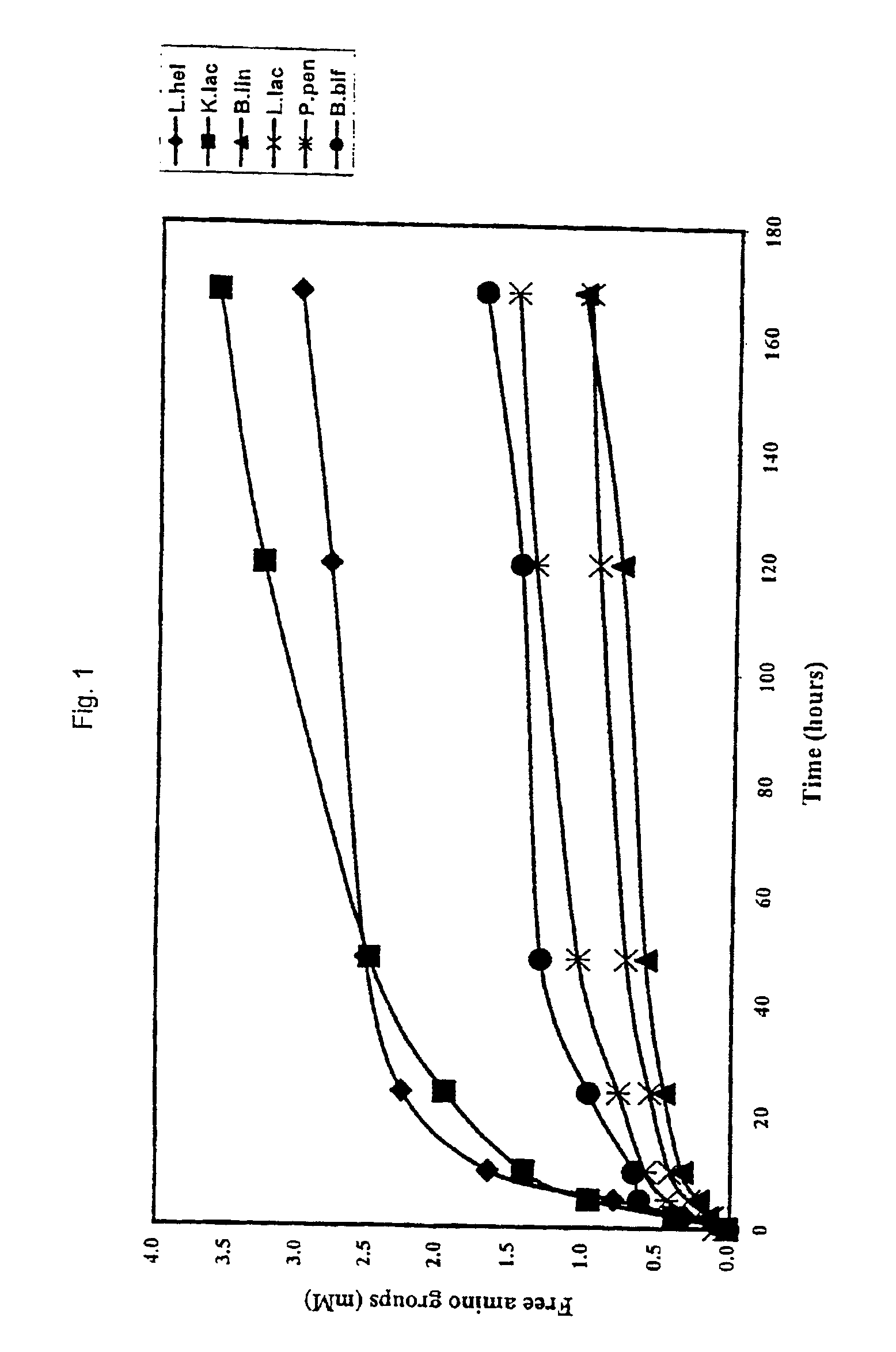Kluyveromyces lactis as attenuated starter
a technology of kluyveromyces lactis and starter, which is applied in the field of cheese production, can solve the problems of reducing the ripening rate of kluyveromyces lactis, extending the ripening time, and reducing the ripening rate, so as to improve the ripening rate, enhance the rate of taste-, flavour- or texture formation, and extend the range of tastes, flavours or textures
- Summary
- Abstract
- Description
- Claims
- Application Information
AI Technical Summary
Benefits of technology
Problems solved by technology
Method used
Image
Examples
example 1
Culturing of Kluyveromyces lactis
[0047]Kluyveromyces lactis was grown in a liquid YEG-medium (10 g / l Yeast extract, 20 g / l Bactopeptone and 20 μl dextrose), pH=6.5 at 30° C. Culturing proceeded in 3 steps.
Step 1—Preparation of Frozen Inoculation Material
[0048]In the first step, very dense cell suspensions were prepared in order to be used as inoculation material in subsequent fermentations. Three 500 ml bottles each containing 330 ml of YEG medium were inoculated with one yeast colony coming from a YPD (Yeast Peptone Dextrose) plate. The bottles were incubated in a rotary shaker at 220 rpm for 48 hrs at 30° C. Glycerol was then added to a final concentration of 15% after which the cell suspension was stored at −80° C.
Step 2—Pre-Culture
[0049]Three subcultures at 2% were carried out at 12 hours intervals. The first two subcultures were carried out in tubes of 10 ml of YEG medium and the last one was carried out in a 250 ml bottle containing 50 ml of YEG medium.
Step 3—Large Scale Cult...
example 2
Preparation of a Cell Free Extract of Kluyveromyces lactis
[0051]Frozen cell pellets, prepared according to Example 1 were thawed on an ice bed and resuspended in 50 ml of cold sterile distilled water (OD at 650 nm=30-40) and subsequently disrupted at 1000 Bars in a refrigerated French pressure cell. Undisrupted cells and cells debris were removed by centrifugation at 39,200 g for 20 minutes at 4° C. and the collected supernatant was sterilised by filtration (0,45 micron then 0,20 micron), distributed in sterile Eppendorfs vials and stored at −20° C. until use.
[0052]The protein content of the cell free extracts was determined according to the Lowry method using bovine serum albumin as a standard (Lowry et al 1951). Typically, the cell free extract had a protein content of 2-4 mg / ml depending on the strain.
example 3
Preparation of Beta-Casein
[0053]In order to determine the peptidase activity of the cell free extract of K. lactis and / or lactic acid bacteria, beta-casein was chosen as a substrate because it is a representative cheese substrate and also the most hydrolysed casein fraction in ripened semi-hard cheeses (Ferranti et al., 1997 and Gouldsworthy et al., 1996).
[0054]Beta-casein was purified from milk as described in Le Magnen and Maugas (1992). It was subsequently partially hydrolysed using the endoproteases trypsin (EC.3.4.21.4) and chymotrypsin (EC.3.4.21.1) in order to generate small peptides that are more suitable substrates for the peptidases in the cell free extracts described in Example 2 above. Trypsin was chosen because it has the same specificity as the endogenous milk enzyme plasmin (EC.3.4.21.7).
[0055]A solution of beta-casein, at 10 mg / ml in sterile distilled water, was hydrolysed by a mixture of trypsin (5000 K, Novo Industry A / S, Copenhagen, Denmark) and chymotrypsin (Sigm...
PUM
| Property | Measurement | Unit |
|---|---|---|
| OD | aaaaa | aaaaa |
| pH | aaaaa | aaaaa |
| time | aaaaa | aaaaa |
Abstract
Description
Claims
Application Information
 Login to View More
Login to View More - R&D
- Intellectual Property
- Life Sciences
- Materials
- Tech Scout
- Unparalleled Data Quality
- Higher Quality Content
- 60% Fewer Hallucinations
Browse by: Latest US Patents, China's latest patents, Technical Efficacy Thesaurus, Application Domain, Technology Topic, Popular Technical Reports.
© 2025 PatSnap. All rights reserved.Legal|Privacy policy|Modern Slavery Act Transparency Statement|Sitemap|About US| Contact US: help@patsnap.com


